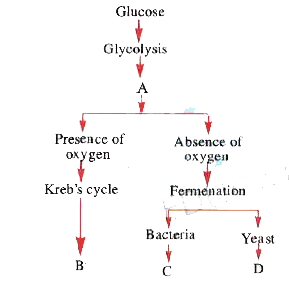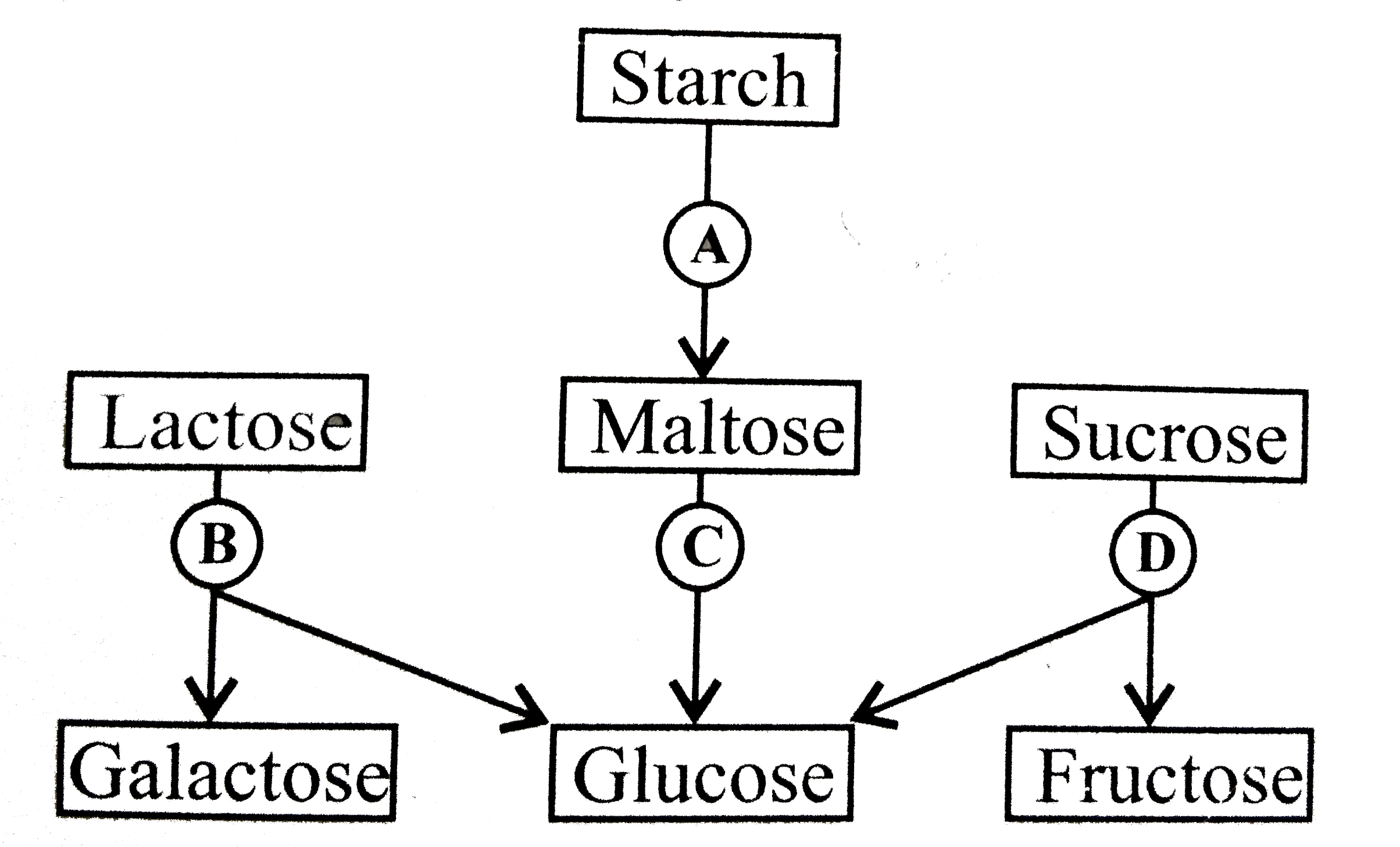The following is a simplified scheme showing the fate of glucose during aerobic and anaerobic respiration. Identify the end products that are formed at stages indicated as A, B, C and D. Identify the correct option from those given below.
 Solution in Telugu
Solution in Telugu
A-Carbon dioxide and water, B-Pyruvic acid, C-Ethyl alcohol and carbon dioxide, D-Lactic acid
A-Pyruvic acid. B-Carbon dioxide and water, C-Lactic acid, D-Ethyl alcohol and carbon dioxide
A-Pyruvic acid, B- Carbon dioxide and water, C-Ethyl alcohol and carbon dioxide, D-Lactic acid
A-Pyruvic acid, B-Ethyl alcohol and carbon dioxide, C-Lactic acid, D-Carbon dioxide and water
The correct Answer is:B
Step by step video & image solution for The following is a simplified scheme showing the fate of glucose during aerobic and anaerobic respiration. Identify the end products that are formed at stages indicated as A, B, C and D. Identify the correct option from those given below. by Biology experts to help you in doubts & scoring excellent marks in Class 12 exams.
Updated on:21/07/2023Topper's Solved these Questions
- RESPIRATION IN PLANTSBOOK - AAKASH SERIESCHAPTER - RESPIRATION IN PLANTSEXERCISE - Exercise-II
27 Videos
- RESPIRATION IN PLANTSBOOK - AAKASH SERIESCHAPTER - RESPIRATION IN PLANTSEXERCISE - Exercise - III
9 Videos
- RESPIRATION IN PLANTSBOOK - AAKASH SERIESCHAPTER - RESPIRATION IN PLANTSEXERCISE - Exercise-I (Aerobic respiration (ETS , BS , Amphibolic)
66 Videos
- PRINCIPLES OF INHERITANCE AND VARIATIONBOOK - AAKASH SERIESCHAPTER - PRINCIPLES OF INHERITANCE AND VARIATIONEXERCISE - EXERCISE -III (Previous AIPMT /NEET Questions)
39 Videos
- TRANSPORT IN PLANTS BOOK - AAKASH SERIESCHAPTER - TRANSPORT IN PLANTS EXERCISE - EXERCISE III
20 Videos
Similar Questions
Choose the incorrect option for why plants can get along without respiratory organs as plants, unlike animals, have no specialized organs for gaseous exchange.
View SolutionWhich statement is wrong for Kreb's cycle?
View SolutionThe incomplete breakdown of sugars in anaerobic respiration results in the formation of
View SolutionWhich of the following most appropriately describes haemophilia?
View SolutionThe water potential of pure water is:
View SolutionThe given flowchart shows the fate of carbohydrates during digestion in the human alimentary canal. Identify the enzymes acting at stages indicated as A,B,C and D and selct the correct option.

View SolutionGiven an account of glycolysis. Where does it occur? What are the end products? Trace the fate of these products in both aerobic and anaerobic respiration.
View SolutionGiven an account of Glycolysis. Where does it occur ? What are the end products ? Trace the fate of these products in both aerobic and anaerobic respiration .
View SolutionThe following is a scheme showing the fate of carbohydrates during digestion in the human alimentary canal. Identify the enzymes acting at stages indicated as A, B, C, and D. Choose the correct option from those given.
View SolutionWhat are the end products of aerobic and anaerobic respiration ?
View SolutionA simple picture of the end of glucose is given during pneumatic and anaerobic respiration. Identify the final products that are formed in the marked A, B, C and D states. Choose the correct option from the options given below.
View SolutionGiven an account of glycolysis. Where does it occur? What are the end products? Trace the fate of these products in both aerobic and anaerobic respiration.
View SolutionThe given flowchart shows the fate of carbohydrates during digestion in the human alimentary canal. Identify the enzymes acting at stages indicated as A, B, C and D and select the correct option.

View SolutionThe given flowchart shows the fate of carbohydrates during digestion in the human alimentary canal. Identify the enzymes acting at stages indicated as A,B,C and D and selct the correct option.

View SolutionEnd product of anaerobic respiration is
View SolutionThe following scheme shows the fate of carbohydrates during digestion in the human alimentary canal. Identify the enzymes acting at stages indicated as A, B, C and D :-
View Solution
